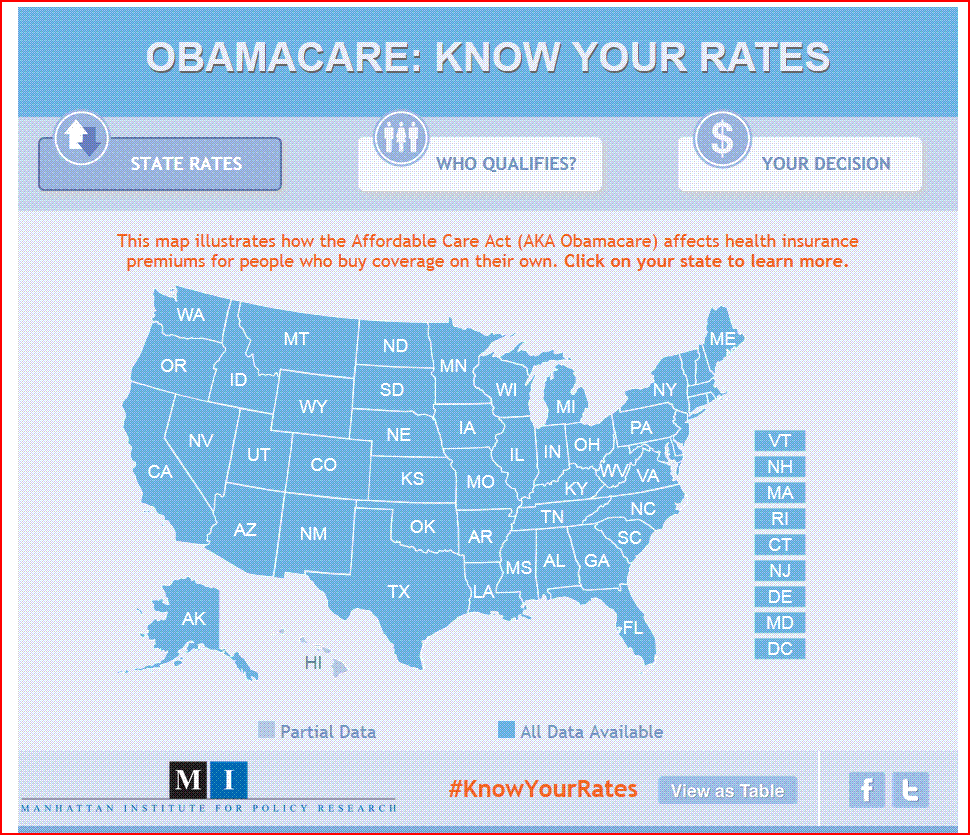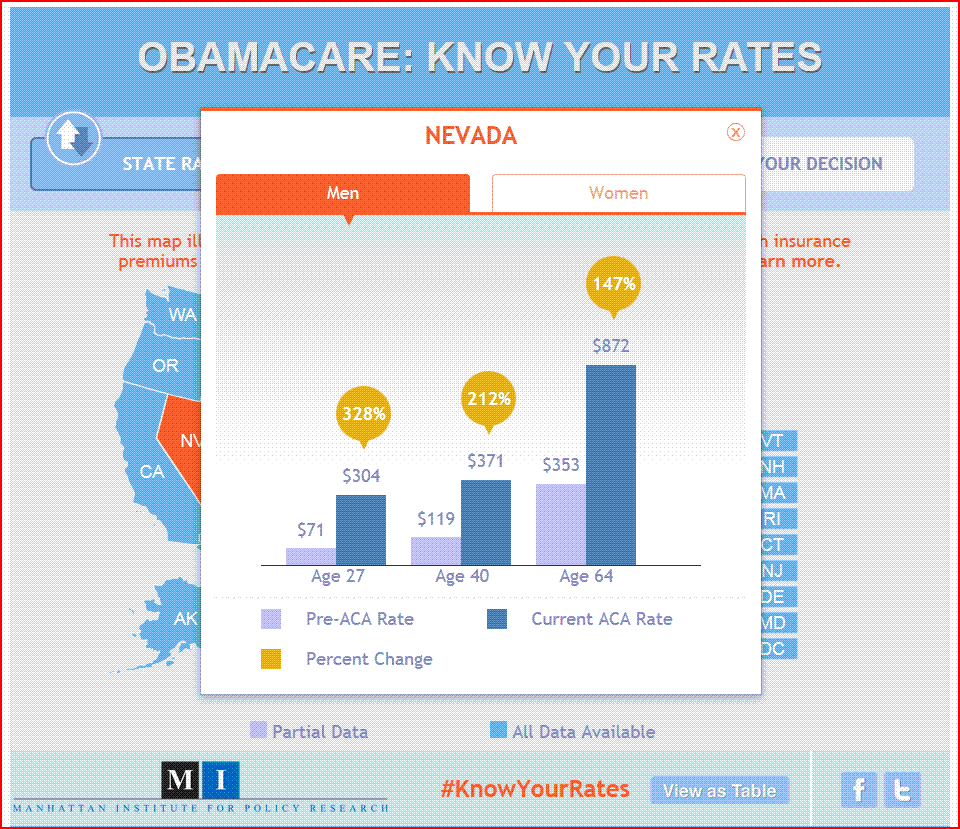LAS VEGAS — The vast majority of Americans are facing higher costs for their individual health-insurance premiums, unless — as more and more are demanding — Obamacare itself goes under the knife.
But today it’s Nevadans, on average, who are facing the steepest increases.
That’s one of the key findings of what is being billed as the most comprehensive analysis yet conducted of premiums facing people who shop for their own coverage under the so-called Affordable Care Act.
 That analysis — in the form of a simple, interactive map — was produced by analysts Yevgeniy Feyman, Avik Roy and Paul Howard of New York’s Manhattan Institute.
That analysis — in the form of a simple, interactive map — was produced by analysts Yevgeniy Feyman, Avik Roy and Paul Howard of New York’s Manhattan Institute.
While the average state will face a premium increase of 41 percent, the average increase facing Nevadans is over four times that, at 179 percent — the most in the nation, according to the new report.
“As we have long expected,” wrote Roy on his ‘The Apothecary’ page on Forbes.com, “the steepest hikes will be imposed on the healthy, the young, and the male. And Obamacare’s taxpayer-funded subsidies will primarily benefit those nearing retirement — people who, unlike the young, have had their whole lives to save for their health-care needs.”
The new Manhattan Institute analysis contains both premium and subsidy data for every state except Hawaii, utilizing data contributed by the consumer-finance service portal, Value Penguin.
Feyman told Nevada Journal that “Value Penguin was a huge, huge help,” when the project needed information for the 34 states that opted not to build a state website under Obamacare, and that the HealthCare.gov website was intended to serve.
The problem was not just the bad data coming off HealthCare.gov and its widely publicized crashes, Feyman indicated. It was also because the Obama administration consciously chose to block easy access for potential customers to rate information. That meant, he said, that “a lot of the rates” had to be identified some other way.
“Basically what the Obama administration does there [on Healthcare.gov] is, if you try to window-shop, they’ll show you two rates — one for people under 49 and one for people over 49, which really doesn’t tell you very much.”
Thus the Value-Penguin data allowed the trio to identify plan costs for those 34 states.
For the first phase of the Nevada analysis, said Feyman, he and his colleagues looked at the plans currently available, pre-Obamacare. Then they identified the five cheapest plans available in the state under Obamacare.
“For the third part of the map,” he said, “the ‘Your Decision’ section, what we did there is look at the median income of the typical 27-year-old in Nevada, the typical 40-year-old and the typical 64-year-old.
“And by looking at that, we were able to build this kind of composite family unit, and look at what the typical person in that family unit would be getting in subsidies, and how much they would be paying for health insurance after the tax credits.”
 Nevada Journal asked Feyman why Nevada’s individual insurance plans — under the ironically misnamed “Affordable Care Act” — turn out to be so uniquely onerous, the highest in the U.S.
Nevada Journal asked Feyman why Nevada’s individual insurance plans — under the ironically misnamed “Affordable Care Act” — turn out to be so uniquely onerous, the highest in the U.S.
One factor, he said, is that in Nevada, as in many states in the South and the Southwest, the insurance marketplace has been relatively unregulated, compared to much of the country.
“So you add on a lot of regulations and plans certainly become more expensive,” said Heyman. Moreover, “some of the really cheap plans in Nevada before the ACA had a really high rate of denials and surcharges.”
Then, in addition, “you’re not allowed to deny anyone or offer anyone a high rate based on pre-existing conditions” — driving up costs even further.
Another factor in Nevada’s plight, he indicated, is that Obamacare continues the much criticized and politicized policy of preventing people from buying their health-insurance policies across state lines.
Since the Silver State still has a relatively small population, that means Nevadans’ insurance claims must be spread over a relatively small risk pool.
“Where you start off from in terms of the size of your original market matters a lot,” said Heyman, explaining that an important reason why Californians in the individual market aren’t facing the kind of rate hikes Nevadans are is because “you have a huge risk pool there,” of around 2 million people.
That “means that any of these rate increases are going to be spread over a much, much larger number of people,” he said, making the Obamacare sticker shock “a little more moderate in California than in Nevada.”
Actually, because of the huge size of California’s individual insurance market, said Feyman, that market ends up being one of the freest in the U.S.
He was quick to add, however, that “it is difficult to characterize any insurance market in the country, really, as being free,” given that the federal tax advantages given the employer-provided insurance market “pretty much wrecks the individual market.”
Steven Miller is the managing editor of Nevada Journal, a publication of the Nevada Policy Research Institute. For more in-depth reporting, visit https://nevadajournal.com/ and http://npri.org/.
